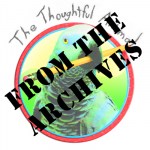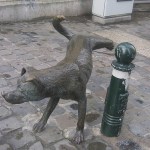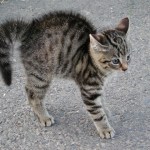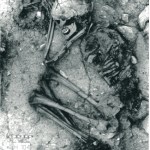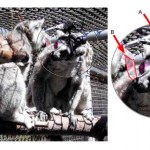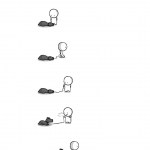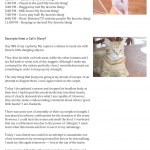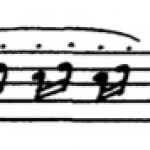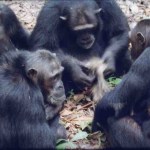mammals
A new piece by me today at the Scientific American Guest Blog, on some exciting news from the Jane Goodall Institute and Duke University:
Fifty years ago, in the summer of 1960 - the same year that a US satellite snapped the first photo of the Earth from space, the same year that the CERN particle accelerator became operational, the same year that the Beatles got their name - a 26-year-old Jane Goodall got on a plane in London and went for the first time to Gombe Stream Game Reserve, in Tanzania. She carried with her only a notebook and some old binoculars. Almost every day since the day…
I've got a new piece over at the Scientific American Guest Blog:
On Friday, March 11, Japan was rocked by an earthquake. People were displaced, a nuclear reactor was in trouble, and the world watched as a tsunami flooded Japan, threatened the islands of the Pacific, and ultimately hit the western coasts of North and South America. Chris Rowan pointed out that "Very little of the devastation resulting from this earthquake was from the initial shaking. This is partly because of Japan's stringent building codes. But mainly because any damage from the seismic waves that sent skyscrapers in Tokyo…
Via the Smithsonian Channel:
Gudrun Pflueger, first seen in A Woman Among Wolves, returns to wolf country after a grueling and terrifying bout with cancer.
Determined to fight for the wolves who gave her the strength to survive her illness, Pflueger battles freezing temperatures and personal setbacks to track the wolves in the wild. The data she collects in the wolves' dwindling habitat may one day help stave off extinction of this keystone species. Witness the dramatic story of survival and endurance that culminates in nothing less than a scientific miracle.
Throughout the month of March…
Welcome to the third installment of Animal Territoriality Week. See part 1 here, and part 2 here.
In 1994, a disease called sarcoptic mange swept through Bristol's fox population, severely crippling the population and killing most of the individuals. Professor Stephen Harris of the University of Bristol, who had been studying the movements and territories of those foxes, noticed that as the animals in one territory died, neighboring foxes were able to colonize the vacant areas in 3-4 days. He suspected that this was because the scent marks of the foxes remained active for 3-4 days, but didn'…
Welcome to the second installment of Animal Territoriality Week. Today, we'll look at a case where differences in territory size can have implications for neuroanatomy. If you missed part 1 of Animal Territoriality week, check it out here.
Let's say you have two very very closely related species. You might even call them congeneric, because they are from the same taxonomic genus. In most ways, these two species are very similar, but they differ behaviorally in some very big ways. Might those behavioral differences predict neurobiological differences?
The different species of the genus…
Welcome to Territoriality Week! Every day this week, I'll have a post about some aspect of animal or human territoriality. How do animals mark and control their territories? What determines the size or shape of an animal's territory? What can an animal's territory tell us about neuroanatomy? Today, I begin by asking two questions: first, what is the functional purpose of establishing territories? Second, to what extent can we apply findings from research on animal territorial behavior to understanding human territorial behavior?
It seems that everyone becomes an amateur animal behaviorist…
The narrator laureate of the science world, David Attenborough, describes the birth of a baby grey kangaroo.
Our friends at BBC Earth describe the video:
In this video a kangaroo is born, crawls up to its mother's pouch where a camera captures it's development from tiny, naked, grub-like newborn into a fully grown Joey.
It's amazing how the baby worm-like kangaroo is born automatically knowing how to get up into the mother's pouch. Incredible.
Lots of animals are well aware that bigger means scarier. In stressful or aggressive situations, for example, the hair or fur of chimpanzees, rats, cats, and even humans stands up on end (in humans, given our lack of fur, this results in goose bumps) in an effort to dissuade a potential attack. Elephant seals use a display called "rearing up" to make themselves look bigger - as if they need to look bigger in the first place!
Since some animals tend to be good at looking bigger than they truly are, visual cues may not actually be a reliable method of sizing up another individual. In addition…
There is a small bit of land, only about a square kilometer, that has added a new wrinkle to the story of animal domestication. This bit of land located in Northern Jordan, just southeast of the Sea of Galilee near the banks of the Jordan River, is home to an archaeological site known as 'Uyun al-Hammam. One key feature of this site, excavated in 2005, is a burial ground containing the remains of at least eleven humans in eight different gravesites. The early humans were buried here sometime during the pre-Natufian period, or around 16,500 years ago.
Layout of the 'Uyun al-Hammam site, and…
This photo, titled "Zookeeper Ernie Bowman and Hippopotamus, Joan, London, 1934" comes to us via The Guardian.
Comment with your best photo caption - as many as you want. Winner will get a limited edition Scienceblogs Thoughtful Animal mug. I will chose a winner in 24 hours.
The photo is © 2011 Curatorial Assistance, Inc/E.O. Hoppé Estate Collection
Most dog owners think that their dogs can tell what they're thinking. Or at least, in some sense, they will insist that their pet pooches can sense their emotions, and respond accordingly.
Indeed, a man by the name of Karl Krall (say that three times fast) thought that there exist some sort of psychic connections between man and animal. And he thought he could prove it.
In this telepathy experiment between human and dog Karl Krall (on the right) tried to detect the thinking radiation he assumed to flow between the two. Krall was a rich dealer in diamonds who had founded his very own…
Behold! The second installment of the Science Online Lemur Cognition series. If you missed the first installment, you should check out the cyborg lemurs of the Duke Lemur Center.
There's some pretty good evidence that numerical cognition emerged fairly early in the primate lineage, at least, if not significantly earlier in evolution. Most of the work on numerical cognition in non-human primates, however, has focused on a handful of monkey and ape species. The prosimian suborder of primates, however, which includes lemurs, diverged from the main primate lineage some 47-54 million years ago. If…
In honor of Science Online, which begins on Thursday night, I will be writing about lemurs this week. Why lemurs? Because on Friday morning, as a part of Science Online, I will be taking a tour of the Duke Lemur Center.
It is common among animals - especially primates - to orient their gaze preferentially towards other individuals, as well as to follow the gaze of others. Lots of attention has been paid to gaze-following, in part because the ability to recognize and orient to the behavior of others is missing or impaired in various developmental disorders, such as autism. It is well known…
If this doesn't tug on the heartstrings, at least a little bit, you may not be quite human.
As with yesterday's post, I don't know where this came from or who wrote it. If you do, please let me know so I can properly attribute it. It is again, a very "tall" image, so I've placed it behind the fold.
Click to enlarge.
I'm not sure where this is from, or who made it (if you do, though, please let me know so I can give it proper attribution). But I think its hilarious and awesome. The image is particularly large, though, so I've placed it behind the fold.
Click to enlarge:
Sometimes, when trolling through your institution's journal subscriptions online, you wander into a treasure trove. I happened upon such a treasure trove recently: the Journal of Animal Behavior, which was published for just six years, between 1911 and 1916.
The studies described in this journal were being conducted at a time when experimental psychology was just emerging as a serious scientific discipline. In 1881, for example, Wilhelm Wundt organized the first scientific journal devoted to psychological science. The first laboratory for experimental psychology was established at Yale…
Eric M. Johnson and I spent about 45 minutes discussing "evolutionary psychology beyond sex" last night, which you can see today on Bloggingheads "Science Saturday."
Or just watch it here:
"Two chimps had been shut out of their shelter by mistake during a cold rain storm. They were standing dejeted, water streaming down their shivering bodies, when Professor Köhler chanced to pass." Upon opening the door for the two chimps, Dr. James Leuba recounts, "instead of scampering in without more ado, as many a child would have done, each of them delayed entering the warm shelter long enough to throw its arms around his benefactor in a frenzy of satisfaction."
"Chimpanzees," primatologist Frans de Waal points out, "do not normally hug their caretakers for no reason." It's a compelling…
In one of a series of stories on animal intelligence, Anderson Cooper went to see Kanzi, probably the most famous bonobo in the world, and primatologist Sue Savage-Rumbaugh, who has worked with Kanzi almost his entire life. Using his board of symbolic "lexigrams," Kanzi apparently indicated that Cooper should don a bunny suit. One wonders whether the producers asked Savage-Rumbaugh to selectively interpret Kanzi's intentions in that way, and how much footage wound up on the cutting room floor. In any case, its actually pretty funny.
This amazingly clear 3D ultrasound image of an elephant fetus was taken just three months into its 22-month-long gestation period. The little guy, now named George, was born nineteen months later at ZSL's Whipsnade Zoo.
You can even see his little trunk and everything!
(h/t Metro UK)
